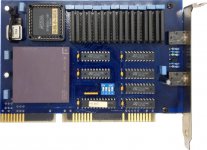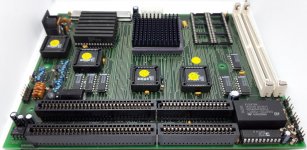Chr$
Experienced Member
Hello from Saxony, Germany. I'm Chris, a new member here.
The Sinclair QL doesn't have it's own section! Which is no surprise as the Motorola 680008 based system was a total flop when sold new 1984 to 1986. Most were sold on its home turf, the UK, and some in Germany and other European countries (about 150,000 computers in total). It was also sold in the USA, but in very low numbers.
In was intended to be a cheap business PC, and it certainly was a lot cheaper than the competition at the time, but it wasn't all that well equipped (no floppy drives, instead it had twin Sinclair microdrive 'stringy' 100k tape drives), only 128k RAM and initially it was very buggy and for early customers also very late. It came bundled with some business software including a word processor and a spread sheet program, which weren't bad for the time (except the early versions were also buggy).
I like the QL though, and have a medium size collection of software and related hardware. I love recovering data from microdrive cartridges, there is a lot of stuff that is MIA and you never know what you might find!
What I also like about the QL, is that even after it was dropped by it's manufacturers, other small companies continued to develop the hardware and made a huge number of improvements, e.g. beefed up RAM (up to 4mb in the early 90s), faster processors, floppy interfaces, a new OS to replace the QL OS that was known as QDOS, hard drive systems and there were even new computers that were based on the QL architecture right up to the early 2000s (in fact there still is - the Q68, but there is a waiting list). There was also an ISA QL card (the QXL/QXLII) that was sold in the mid 90s that you could fit into a PC and it would use the PC I/O but had its own CPU and RAM. For a time QL based systems could keep up with contemporary IBM compatibles despite the fact that less software was developed for them. There was a hardcore QL userbase for many years, some of which are still active. There is even new hardware being made for the QL. So, although most people gave up on the QL very early on, because it was rubbish out of the box - there have been so many interesting developments over the years.
Anyone else here has any involvement or memories of QL systems?
The Sinclair QL doesn't have it's own section! Which is no surprise as the Motorola 680008 based system was a total flop when sold new 1984 to 1986. Most were sold on its home turf, the UK, and some in Germany and other European countries (about 150,000 computers in total). It was also sold in the USA, but in very low numbers.
In was intended to be a cheap business PC, and it certainly was a lot cheaper than the competition at the time, but it wasn't all that well equipped (no floppy drives, instead it had twin Sinclair microdrive 'stringy' 100k tape drives), only 128k RAM and initially it was very buggy and for early customers also very late. It came bundled with some business software including a word processor and a spread sheet program, which weren't bad for the time (except the early versions were also buggy).
I like the QL though, and have a medium size collection of software and related hardware. I love recovering data from microdrive cartridges, there is a lot of stuff that is MIA and you never know what you might find!
What I also like about the QL, is that even after it was dropped by it's manufacturers, other small companies continued to develop the hardware and made a huge number of improvements, e.g. beefed up RAM (up to 4mb in the early 90s), faster processors, floppy interfaces, a new OS to replace the QL OS that was known as QDOS, hard drive systems and there were even new computers that were based on the QL architecture right up to the early 2000s (in fact there still is - the Q68, but there is a waiting list). There was also an ISA QL card (the QXL/QXLII) that was sold in the mid 90s that you could fit into a PC and it would use the PC I/O but had its own CPU and RAM. For a time QL based systems could keep up with contemporary IBM compatibles despite the fact that less software was developed for them. There was a hardcore QL userbase for many years, some of which are still active. There is even new hardware being made for the QL. So, although most people gave up on the QL very early on, because it was rubbish out of the box - there have been so many interesting developments over the years.
Anyone else here has any involvement or memories of QL systems?


